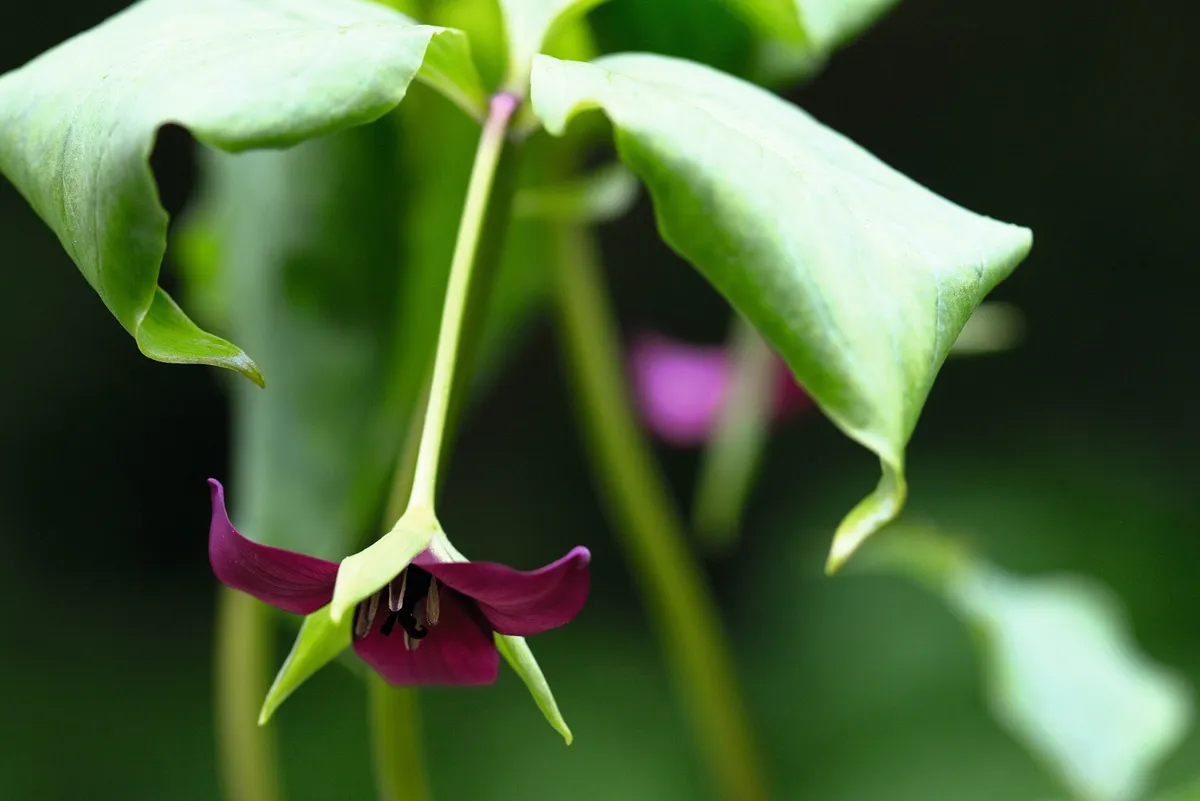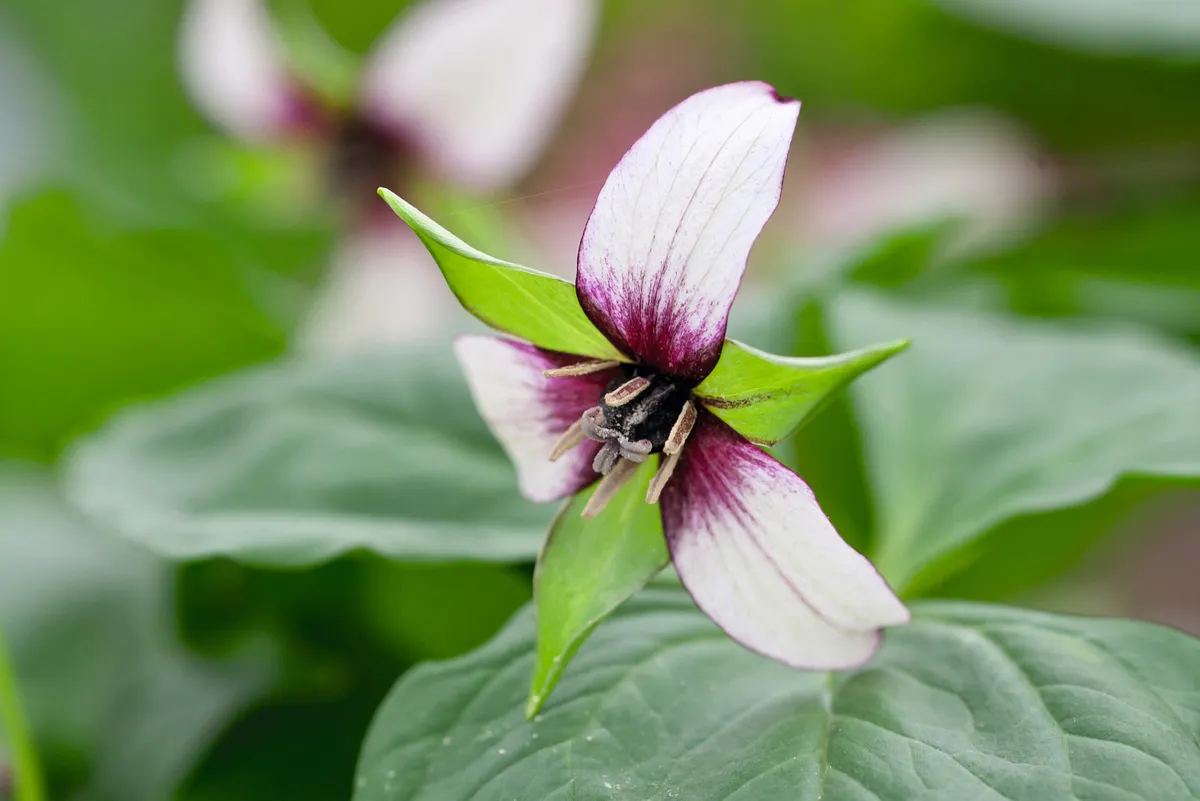Trilliums can have an expensive price tag and be tricky to cultivate, which often puts gardeners off growing them. But with a little perseverance, these shade-loving plants are worth the extra effort and expense. Here, plant expert Val Bourne advises on growing trilliums, and recommends the best to grow.
- Where to grow trilliums
- When do trilliums flower?
- How to plant trilliums
- Caring for trilliums
- What to grow with trilliums
- The best trilliums to grow
IN BRIEF: TRILLIUMS
What Spring-flowering woodlanders with flower, sepals and leaves arranged in threes or sometimes multiples of three. Some have stalkless flowers, while others bear slender stalks topped with small flowers.
Origins Debate rages about how many species there are, as many variations are found in the wild. There are around five or six native to eastern Asia, while the rest, around 43 species, are from North America.
Size Up to 60cm, but when happy trilliums will form wide clumps.
Conditions Rich loamy, humus-rich soil in light shade. A leaf litter mulch helps to keep the soil cool and may make the soil slightly acidic, which trilliums prefer.
How to grow trilliums

For best results start off with good material, preferably a pot-grown trillium that has more than one flower, or you could buy a rhizome from a nursery specialising in trilliums.
Where to grow trilliums
Trilliums need friable soil that holds moisture but is free-draining. They are best grown under deciduous trees and shrubs. Provide shelter from summer sunshine and autumn winds, and give them space to shine.
When do trilliums flower?
Trilliums flower in March and April.
How to plant trilliums
If you choose to plant rhizomes, these need to be planted as soon as they arrive, in friable soil enriched with leaf mould or leaf litter, and planted with their tip just below the surface. Bought plants should be planted level with their depth in the pot.
Caring for trilliums
- Dress with well-rotted leaf litter in late autumn, but do not cover the crowns.
- Feed your trilliums to keep them in leaf for as long as possible. Sprinkle a slow-release fertiliser, such as Vitax Q4 (vitax.co.uk), round them in late winter and then foliar feed them with seaweed extract.
- Once established, trilliums endure without disease, but slugs will eat seedlings and plants. Once they emerge, keep slugs at bay, as they can, and do, mar the foliage and flowers.
- Ideally, clumps should be left undisturbed, but if you need to divide them, do so in May, June and July when the leaves are still attached.
Growing trilliums from seed
Seeds need to be sown when ripe. Plant societies, such as The Alpine Garden Society often have them on their seed list. You’ll need patience if growing from seed. Nothing will appear for 18 months, as trillium seeds need two warm spells and two cold spells.
Eventually, single leaflets (reminiscent of a lily) will rise up and then go dormant within a month or so.
The pot must be allowed to bake in summer and then be subjected to cold in winter. The process is repeated over several years, usually seven, before a flower appears.
Nursery growers speed the process up by placing the tiny rhizomes in a refrigerator for six weeks, to shorten the dormancy period. They also score mature rhizomes behind the terminal bud to encourage new growth.
What to grow with trilliums
Trilliums work well with other woodland plants such as erythroniums, which flower at a similar time and enjoy similar conditions. Erythronium californicum ‘White Beauty’, Erythronium revolutum ‘Knightshayes Pink’ and Erythronium ‘Hidcote Beauty’ make particularly good companions. Read our guide to growing erythroniums.
Ferns, especially the black-bristled Himalayan form of Dryopteris wallichiana, also work well with trilliums. Cut back in late-autumn, it will produce new fiddle- necked fronds in late April without harbouring slugs (as Polystichum can) or impinging on trillium growth. Maidenhair ferns also make good companions, because they become dormant during winter. Read our guide to growing ferns.
Other good companions for trilliums include hepaticas, Sanguinaria canadensis, snowdrops and hellebores.
The best trilliums to grow
Trillium kurabayashii

A showy species with sultry red-to-purple bracts and sepals above strongly marked foliage. This particular form was sourced from Harvington Clone A, a seed-raised trillium, which means that variations can and do occur as is generally true for many seed-raised trilliums.
Height: 50cm.
Trillium erectum

This dainty trillium flowers early, and loves acid soil. Its petals (normally wine-red) and green sepals, are held on a stalk above bright foliage. Can suffer frost damage.
Height: 60cm. AGM. RHS H5, USDA 4a-7b.
Trillium sulcatum

Broad-petalled, wine-red flowers, with quilled, dark and narrow sepals behind, are held on stalks above large, rounded leaves. The flowers, which curtsey slightly, smell musty and attract flies.
Height: 45cm. USDA 3a-9b.>
Trillium flexipes ‘Harvington Dusky Pink’

A strong hybrid of Trillium flexipes and Trillium sulcatum that took Hugh Nunn ten years to select and raise. Its dusky pink flowers are framed by narrow, red-edged sepals, and the strong stems also have a pink-flush.
Height: 38cm.
Trillium vaseyi

A sweetly fragrant, maroon-red trillium that carries its flowers under the foliage on an almost horizontal stalk making the flower look as though it’s nodding. Hides its flowers perhaps a little too well.
Height: 60cm. USDA 5a-8b.
Trillium flexipes a Harvington selection

A good selection from Trillium flexipes with rounded green foliage topped with cream-white flowers and a pale pink ovary (rather than the usual creamy-white one). This strong-growing trillium is tolerant of lime, being found naturally on wooded limestone slopes.
Height: 50cm.
Trillium simile

Each of its creamy-white flowers has an attractive dark eye in shades of purple and midnight-blue, resembling a miniature clematis flower. It clumps up well in humus-rich, damp soil.
Height: 45cm. USDA 3a-9b.
Trillium grandiflorum

Possibly the best-loved trillium, with full-petalled, large, white flowers that can vary in size and are held on stems above dark-green foliage. Flowers later than many in May and June.
Height: 45cm. AGM. RHS H5, USDA 3a-9b.
Trillium ‘Harvington Star’

An elegant, creamy-white hybrid of Trillium simile and Trillium flexipes ‘Harvington Selection’. Narrow petals, separated by slender green bracts, form starry flowers with a dark red ovary at the centre.
Height: 40cm.
Trillium albidum

A showy, early flowerer with freesia-scented, pale flowers and lily-green bracts set above green-veined, slightly ruffled foliage that can be splashed in shades of grey-brown and creosote.
Height: 50cm. AGM. RHS H5, USDA 3a-9b.
Trillium luteum

As its name, yellow wood trillium, suggests, this showy trillium needs shady conditions. Stays in flower for weeks so very garden worthy and colour develops as flowers mature.
Height: 30cm. AGM. RHS H5, USDA 4a-7b.
Trillium ludovicianum

Known as the Louisiana trillium, this has strongly marked leaves and erect flowers, which can vary from green through to purple. The wavy-edged petals are set around upright, wide stamens.
Height: 30cm. USDA 7a-8b.
Trillium grandiflorum f. roseum

Cool-pink flowers, rather like most montana clematis in colour, held above all-green foliage, which has a red picotee edge due to presence of anthocyanin. Pink forms are locally frequent in the Blue Ridge Mountains of Kentucky, although Hugh Nunn’s pink forms originated in Virginia.
Height: 45cm. RHS H5.
Trillium rivale

This small trillium with red-speckled white flowers loves stream edges, but will need drainage and moisture to do well. Less hardy than some, it’s often grown in an alpine situation.
Height: 15cm. AGM. RHS H4, USDA 5a-9b.
Trillium rugelii

Broad, green foliage and a curving stalk that tucks the flower under the foliage typify this robust species. Its distinctive flowers have strongly recurved petals that turn back on themselves.
Height: 45cm. USDA 3a-9b
Trillium grandiflorum f. polymerum ‘Flore Pleno’

The most desirable trillium of all for most gardeners, with double white flowers set above all-green foliage. It’s later than the single form and doesn’t set seed because most forms are sterile. Propagation demands division and this makes it expensive, but the fully petalled flowers last much longer than the single forms.
Height: 45cm. RHS H5, USDA 3a-9b.
Where to buy trilliums
Edrom Nurseries
School Road, Coldingham, Eyemouth, Berwickshire TD14 5TZ.
Tel 01890 771386, www.edrom-nurseries.co.uk
Twelve Nunns
16 Carisbrook Grove, Stamford, Lincolnshire PE9 2GF.
Tel 01778 590455, www.twelvenunns.co.uk


